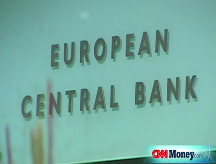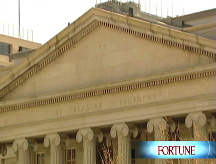Bond prices fall
Investors respond to bank rescue, weak corporate results and grim economic reports.
NEW YORK (CNNMoney.com) -- Prices for U.S. Treasurys fell Friday as the government's latest efforts to stabilize the shaky financial services sector outweighed grim economic data and weak corporate results.
The retreat came as the government decided to extend another $20 billion to Bank of America, which encouraged investors to seek higher returns in the stock market.
But the sentiment was tempered in the afternoon, with stocks giving back gains, as the outlook for the banking sector remained grim and Friday's economic data highlighted the challenges facing the economy.
"The fundamentals in growth and inflation data are still bearish," said Steve Van Order, chief fixed-income strategist at Calvert Funds.
At the same time, the market is expecting an influx of supply as the government issues more debt to cover the cost of its myriad bailout and stimulus plans.
The Congressional Budget Office said last week that the U.S. budget deficit in fiscal year 2009 could jump to a record $1.2 trillion.
"There are a lot of conflicting forces that are pushing Treasurys around day to day," Van Order said.
Bank drama: Early Friday, Bank of America received another $20 billion from the federal government's bailout fund, along with guarantees on $118 billion of assets at the bank, to absorb its recent purchase of the Merrill Lynch.
The move helped reassure the market that "the government will respond in size and in a coordinated fashion," to the ongoing financial crisis, Van Order said.
The emergency aid was accompanied by steep quarterly losses in the banking sector.
Bank of America (BAC, Fortune 500) posted a net loss of $1.79 billion in the fourth quarter of 2008, compared to earnings of $268 million in the same period in 2007. Merrill Lynch, meanwhile, posted a $15.31 billion loss Friday before the opening bell.
Citigroup (C, Fortune 500) reported a much bigger-than-expected $8.3 billion quarterly loss Friday along with plans to split up the business model into the Citicorp banking unit and the Citi Holdings unit for brokerage and other business.
More bailouts: But it wasn't just the banking sector which was getting more cash from the government.
Obama was granted access to $350 billion of the original $700 billion financial services bailout package. The Senate voted down a measure that would have prevented the release of the funds on Thursday.
The auto industry was still looking for help. General Motors decreased its expectations for auto sales in the U.S. on Thursday, an indication that the struggling company could try to go back to the government's bailout kitty for more help.
Economy: A flurry of economic data also weighed on the Treasury market Friday.
The Labor Department's Consumer Price Index, a measure of inflation, declined a seasonally adjusted 0.7% in December from the prior month. It was the third consecutive decline and was led by a sharp drop in energy prices.
On an annual basis, CPI edged up 0.1% in 2008, the weakest annual increase since 1954. Striping out volatile food and energy costs, however, the index was unchanged.
Treasurys, like most bonds, are highly inflation-averse because rising prices can severely undermine the value of fixed-income assets. Conversely, signs that prices are falling typically support Treasurys.
A separate report showed that consumer confidence unexpectedly increased in January.
The Reuters/University of Michigan index of consumer confidence rose to 61.9 in January from December's 60.1. While the reading was above economists' forecast of 59, the index remains near historically low levels.
Meanwhile, figures from the Federal Reserve showed that industrial production dropped by a bigger-than-expected 2% in December.
Industrial production was down 7.8% versus December 2007, the biggest drop since September 1975, as the global recession weighs on the manufacturing sector.
Debt prices: The benchmark 10-year bond fell 1-8/32 to 112-10/32 and its yield rose to 2.34%. Bond prices and yields move in opposite directions.
The 30-year bond sunk 1-3/32 to 131-4/32 and its yield jumped to 2.91%. Meanwhile, the 2-year note edged lower by 1/32 to 100-9/32 and its yield rose to 0.73%.
And the yield on the short term 3-month bill was 0.12%, even with Thursday. The 3-month note is considered a gauge of investor confidence because money market funds tend to shuffle cash into and out of the bill as they assess the risk in other parts of tech marketplace. A lower yield indicates higher demand.
Lending rates: On Friday, the 3-month Libor rate rose to 1.14% from 1.09% Thursday, according to data available from Bloomberg.com. And the overnight Libor rate also increased, moving to 0.14% from 0.12% Thursday.
Libor - the London Interbank Offered Rate - is a daily average of rates 16 different banks charge each other to lend money in London, and it is used to calculate adjustable-rate mortgages. More than $350 million in assets are tied to Libor.
Two credit market gauges showed slightly decreased confidence in the credit market Friday.
The "TED spread" broadened to 1.02 percentage points from 0.97 percentage point Thursday. The higher the spread, the less willing investors are to take risks. The rate widened to historic levels as the credit market froze in the fall. As central banks around the world have eased lending rates and worked to increase liquidity in the marketplace, the spread has come back down.
Another market indicator, the Libor-OIS increased to 0.95 percentage point from 0.90 percentage point Thursday. The Libor-OIS spread is a measure of how much cash is available for lending between banks, used for determining lending rates. The bigger the spread, the less cash is available for lending. ![]()




